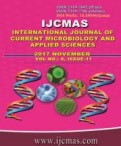


 National Academy of Agricultural Sciences (NAAS)
National Academy of Agricultural Sciences (NAAS)

|
PRINT ISSN : 2319-7692
Online ISSN : 2319-7706 Issues : 12 per year Publisher : Excellent Publishers Email : editorijcmas@gmail.com / submit@ijcmas.com Editor-in-chief: Dr.M.Prakash Index Copernicus ICV 2018: 95.39 NAAS RATING 2020: 5.38 |
Genetic divergence analysis following Mahalanobis D2 statistics revealed considerable genetic diversity among 29 genotypes of okra [Abelmoschus esculentus (L.) Moench] for all the eighteen characters which pertaining to the growth, earliness and yield. Twenty nine genotypes were grouped into 5 distinct clusters depending upon the similarities of their D2 values following Tocher’s method. The characters YVMV infestation, fruit length and days to 50% flowering with high per cent of contribution to total divergence were the potent variables in differentiating the breeding material under study. The use of diverse inbred lines from the divergent clusters with high intercluster distance (cluster III and IV, I and III and clusters II and III) in hybridization is expected to result in high heterosis and throw desirable transgressive segregants. The genotypes of two solitary clusters (cluster II and IV) being diverge from others may also serve as potential inbred parents for breeding programmes.
 |
 |
 |
 |
 |